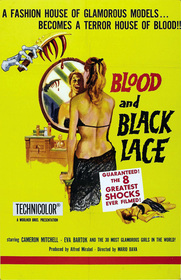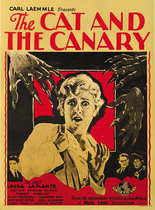Our editor-in-chief Nate Yapp is proud to have contributed to the new book Hidden Horror: A Celebration of 101 Underrated and Overlooked Fright Flicks, edited by Aaron Christensen. Another contributors include Anthony Timpone, B.J. Colangelo, Dave Alexander, Classic-Horror.com's own Robert C. Ring and John W. Bowen. Pick up a copy today from Amazon.com!
Blood and Black Lace (1964)
Sporting one of my favorite movie titles ever, Mario Bava's Blood and Black Lace is a prime example of the Italian horror genre known as giallo. Gialli (the plural form of the word) are basically stylized mystery/horror films containing occasional scenes of intense violence. They are often marked by unnatural yet strangely intriguing lighting techniques. Naturally, gialli tend to become efforts in creating a moving atmosphere. Trying to uncover a secret can only take a film so far, but offering stimulating color use and set design along the way can provide a good boost, depending on what you look for in a film. Blood and Black Lace is light on story but rich in style.
As far as the plot goes, this is your standard murder mystery. Outside a fashion house, a young model is murdered by a masked killer whose appearance is reminiscent of the Phantom of the Opera. Right from the start, everybody acts suspiciously enough to be the killer. When one character finds the diary of the first victim, nearly everyone in the room looks at it with surprise, but we never know whether they are afraid of what is written about them or if they simply want to know what’s inside. The plot for the bulk of the movie offers nothing new or interesting, just some drama, more murder, and guesswork as to the identity of the killer.
The plot does become more fun in the end, though. Instead of following the police through a trail of detective work that leads up to the murderer, director Mario Bava simply shows us who did it about three-quarters of the way through, after a little bit of teasing. These revelations are delivered simply, but they provide some interesting drama for the last twenty minutes of the film. We learn the basics — the murderer’s identity, means, and motives — and though not exactly sympathetic, there is something beautiful and even innocent about the villain. Since this is more than a mystery film, though, our getting to know the killer does not end the story. We witness some of the drama underpinning the murders, and we get to watch one last murder with full knowledge of the killer’s identity and motives, which allows us to view the killing act in a different psychological light. It is a refreshing way to end the film, but there just would have been more to enjoy if the plot had been more concerned with character development.
Thankfully, the film does have more to offer. Even before the killer’s identity is revealed, the film’s primary strategy is not simply to keep you guessing. Like most other gialli, the life of this movie lies in atmosphere. It is not terribly foreboding, but it is emotionally haunting. In other words, it doesn’t leave you depressed but rather mystified at the sets and lighting, which always convey a sense of either emptiness or beauty. This technique is established in the opening credits, in which the camera passes over the actors standing still in dark rooms with mannequins lit in red. In the moments leading up to one murder scene, as the victim walks through a dark antique shop, an ominous blue-green light from a sign on the street slowly strobes on and off, like a warning, or a heartbeat. Moments such as these are contrasted with the non-suspenseful scenes, which are often well-lit, grandiosely decorated, and inhabited by beautiful women. This stylization is kept up throughout the film up until the final, Hitchcockian image: a red phone swinging off the hook in a dark room. The film forces near-constant mood-shifts upon viewers, leaving them emotionally confused.
Adding one more layer to this confusion are the film’s murder scenes, which momentarily rip the viewer out of the atmospheric experience to focus on specific, visceral horrors. There is one kill reminiscent of Bava’s earlier Black Sunday, in which a medieval spiked glove is used to stab a victim through the face. Another murder involves face trauma, too, inflicted by a bright red burning stove. Like the contrasting atmospheric moods, these scenes further disorient the viewers, yanking them from psychological unease to searing pain. Just when we think we’re safe from scenes of violence, Bava hits us with straightforward brutality.
This is really a love-it-or-hate-it film, coming from someone who thinks that that description is vastly overused nowadays. If you’re a fan of Italian horror, or even the haunted house genre (think of this as a haunted town movie), you will definitely enjoy Blood and Black Lace. Its eerie lighting and shocking murders well accomplish the film’s mood-shifting goals. If, however, you’re looking for something with more narrative strength, stick to the American stuff.
This review is part of Mario Bava Week, the last of four celebrations of master horror directors done for our Shocktober 2007 event.








